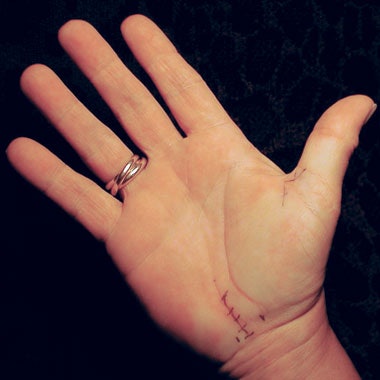
Gina’s Story
“I had numbness and tingling so severe it would wake me up at night. On a doctor’s recommendation, I wore a splint-type immobilizer for two years, but I was still in pain. The more I worked, the worse it got until I had surgery–that’s when I realized just how much pain I had been in.
“I had surgery on my left hand in April 2006, and the right wasn’t done until August 2006. My right wrist took longer to recover, which is was difficult because I’m right-handed. It took about eight weeks after surgery before the incision didn’t hurt. The surgeons used a laser to do it, so my scars are only about an inch long and virtually invisible.
“Recovering from the surgery is all about regaining that muscle memory. Any time it occurred to me, I would squeeze a latex covered Nerf ball. The hardest things to do were writing checks and turning pages. Since my recovery, I do physical therapy exercises throughout the work day, stretching out my fingers and wrists by placing my hands at a 90-degree angle from my wrists and gently pulling my fingers back toward me with my other hand. I stretch out both hands and then spread my fingers wide apart. Rotating my wrists also feels good.
“I’ve made some changes to my techniques since my surgeries; I don’t think I would go back to hand filing now. I use the e-file on all nail enhancements and only use a file during a manicure. With all the different bits available, I can use the e-file for the entire service. The hand piece is so lightweight and has no vibration. I work a 12-hour day of 45-minute to 1-hour appointments with no fatigue or pain in my wrists, hand or arms.
“Working with gels has also taken the strain of doing nails off my wrists. There is less filing with no need to bring up a shine on the surface. And less filing equals less strain. Using the e-file has allowed me to continue doing nails for far longer than I would have been able to, even with the surgery.”
Preventing the Strain
It’s true: an ounce of prevention is worth a pound of cure when it comes to carpal tunnel syndrome. Monica Van Niel, occupational therapist at the Cleveland Clinic in Cleveland, sees hundreds of patients each month, and about 50% of the complaints come from chronic issues, including repetitive stress. To combat these injuries, she recommends exercises to help with hand strength and flexibility. The easiest exercise can be performed between clients, right at your nail station: gently squeezing a stress ball or tennis ball. “This is really the only way to build hand strength,” advises Van Neil. “And it’s important that you have strength in your hands.”
Along with strengthening your hands, flexibility is very important, especially in the wrist. To combat carpal tunnel, Van Neil suggests doing simple wrist rotations and stretching your fingers between appointments. She notes that maintaining proper hand position is also beneficial; Van Neil recommends keeping the wrist in line with the forearm instead of bent in an extreme angle.
Of course, you can’t ignore the rest of your body; stretching is important since we tend to be hunched over most of the day. Van Neil recommends reducing tension in your shoulders by squeezing the shoulder blades together and holding this position for five seconds, and then stretching arms forward. Repeat this easy stretch between clients.
As a final note, Van Neil points to a bad habit that many of us should kick: smoking! Studies show that decreased blood flow to the nerves as a result of smoking also affects the nerves that run though the wrist, contributing to carpal tunnel syndrome.
Many of us truly love what we do, it’s a shame that we might have to cut short an otherwise long-term career. Chart a plan to implement a few of suggestions into your day and you will soon be on the road to a healthier future loving what you do–nails!
Millie Haynam is president and creative director of Natural Beauty Salon and Academy in Twinsburg, OH. She has been an industry professional for more than 30 years. Her awards include Who’s Who in America/Business, Marketing and The Artist and Visionary Award, First Runner Up, Salon of the Year 2004.











